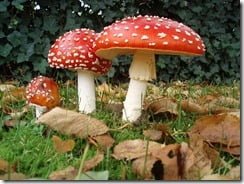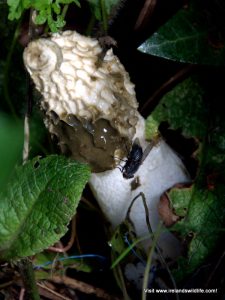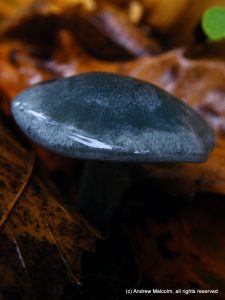 The fly agaric is the classic toadstool of children’s fairytales, unmistakable with it’s large red cap covered with white flecks. It is widespread and common, occurs throughout Europe and North America, and was introduced to Australia, New Zealand and South Africa with pine trees imported from Europe.
The fly agaric is the classic toadstool of children’s fairytales, unmistakable with it’s large red cap covered with white flecks. It is widespread and common, occurs throughout Europe and North America, and was introduced to Australia, New Zealand and South Africa with pine trees imported from Europe.
Fly agaric appears between August and November, and is generally associated with acidic soil beneath birch and spruce trees, with which it forms a symbiotic relationship. Fungi are neither plant nor animal, and belong to a completely separate group of their own. They are unable to use sunlight to produce food, like plants, and instead acquire their nutrients from living or dead plants, animal or other fungi.
The visible part of the fungi is the fruiting body that seemingly appears from nowhere to produce and distribute the fungi’s spores. Beneath the fruiting body is complex network of fine threads, known as hyphae, that permeate the fungi’s food source and absorb the nutrients it needs.
The fruiting body of the fly agaric is a classical mushroom shape. The prominent cap is typically around 12cm (c. 6 inches) in diameter when fully developed, but some specimens may reach sizes of up to 30cm (c.12 inches) in diameter. The cap is a very prominent crimson, which gradually fades to orange and then pale yellow as it ages. It is scattered with white or yellow flecks or warts, which are actually remnants of a protective veil that shrouds the entire mushroom when it first emerges. These flecks can be washed off by rain, or brushed off with a finger. The white stem is from 5-20cm (2-8 inches) long, with a basal bulb that also shows remnants of the protective veil in the form of one or more ragged collars (or ruffs) circling the base.
Fly agaric is considered poisonous. It belongs to the same genus of fungi as the deadly death cap, although it is rarely fatal. In fact, the name fly agaric comes from the old European practice of using this fungi crushed, dipped or sprinkled in milk as an insecticide.
Despite its poisonous properties the consumption of this species in small amounts by indigenous populations is widely documented. The mushroom contains an assortment of psychoactive and hallucinogenic chemicals and has been used in various religious and shamanistic ceremonies for more than 2,000 years. These practices are particularly well documented for the indiginous people of Siberia, where the mushroom is involved in rituals to communicate with the spirit world.
The fly agaric’s religious connections are far reaching. It is widely thought to be the “Soma” talked about in Hindu scriptures, and some also believe it to be the “amrita” mentioned in Buddhist scriptures.
Closer to home, there is a popular myth that Nordic Viking warriors used to consume fly agaric to send them into their berserker rages, although compelling evidence for this theory is hard to find. Another theory, again difficult to substantiate, suggests that Zulu warriors consumed fly agaric before going into battle, and that this, in part, helped them to leave the field victorious after the famous battle against the British army at Isandlwana.
It is suggested that there is a connection between the fly agaric and the modern incarnation of Santa Clause. The mushroom’s red and white livery is reflected in Santa’s robes, and his use of chimneys is said to be symbolic of the Siberian shaman’s habit of entering huts through the smoke-hole in the roof bearing a sack full of these mushrooms. Reindeer are also particularly partial to this mushroom in the wild, and the hallucinogenic properties cause them to prance around wildly for some time – which could partially explain Santa’s association with flying reindeer.
Image Credit: Onderwijsgek at nl.wikipedia









21 comments
Eddie
I’d like to find some ‘chicken of the woods’ but have only seen it once – when i went back to collect some the tree had been cut down !
Do ye come across any lately – is there a season for it ?
Thanks
Grainne
I came across these mushrooms today while out walking the dogs on farm land. In Co. Limerick. Counted at least 30 of them growing in a plot under a pine/spruce tree. All different sizes and just wonderful to see.
Elaine
Saw 2 during the week in woodland in County Wexford. Beautiful
CiaraB
We saw one today at Muckross House Gardens in Killarney National Park. I had never before seen one.
M
Hi. Im living in Ireland Dublin.
Where in Ireland can you find this Fly Agaric?
Thanks
Valeria
You can order fly agaric in this store – https://omshroom.eu/
Gavin K
I seen one while out walking my dog it was growing on a live tree
SANDY ROSE
Though the article is short, but it’s informative. You put something unique information in this. Mushroom is a lovable thing, I appreciate your experience. Thanks for sharing.
Amanita Muscaria
Amanita in alternative medicinwe
https://amanitamuscariashop.com/
Amanita Muscaria
Also Amanita Muscaria is used as alternative medicine treating arthritis and other diseases
https://amanitamuscariashop.com/how-amanita-muscaria-can-help-cure-arthritis-radiculitis-rheumatism-paralysis/
Rose
I just found a small area covered with these beautiful ‘mushrooms’ this morning.
I live in Burnaby, BC . Canada and I know they are also found on Vancouver Island at the Yellow Point Lodge property. They are just so lovely to look at.
Daniel Shields
Thank you for sharing this very informative article and these wonderful photos! I can not stop to be in awe always with nature on how magical it is. I love these shots!
Margaret lydon
Just saw a few of these magic mushrooms while on a walk through grounds of Ashford castle cong.
vastlycurious.com
I have never seen one in the USA …
Calvin Jones
The American “Fly Agaric” is a bit different to its European cousin… and according to this site may even be split into a different species. It seems a number of different species of the Amanita genus are called “fly agaric” Stateside.
vastlycurious.com
Amazing to see !!!
vastlycurious.com
It was amazing to see!
aj vosse
Saw my first ones today… 😉
BurLurv
Very informative, i didn’t think they would grow here in ireland!
Il keep an eye out now 😉
Christy
I found some of these near a faory fort under some pine trees in North Tipperary.
Better trip than LSD! Hon the druids!
Viv Mary Proudfoot
I came across a delightful scene of this mushrooms yesterday, quite a large group of them, around 25 I would say, growing under pine trees. I live in SW Cork.